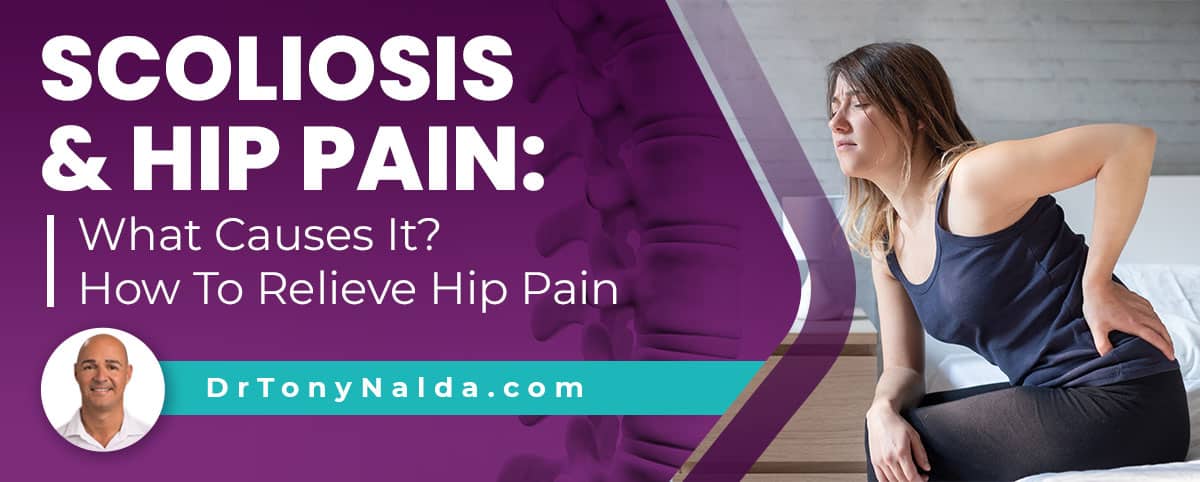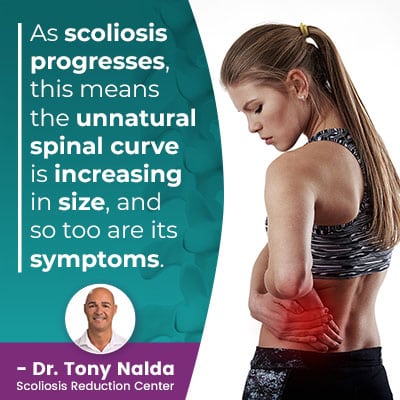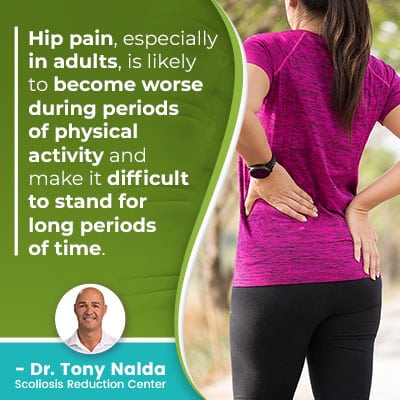Scoliosis & Hip Pain: What Causes It? How To Relieve Hip Pain

Scoliosis can affect the body in numerous ways, from changes to posture, gait, and balance to complications with digestion and lung impairment; the best way to minimize its effects is through proactive treatment that addresses its underlying structural nature. When it comes to hip pain and pain in general, adolescents and adults experience it differently.
Scoliosis is a spinal condition that introduces uneven forces to the body and can cause a myriad of effects felt throughout, including the hips. Hip pain is related to stretched ligaments and postural deviation that causes the pelvis to tilt, making one hip sit higher and take on more weight.
Let’s start our exploration of scoliosis & hip pain by first defining the condition and discussing the parameters that must be met to diagnose scoliosis.
Table of Contents
Understanding Scoliosis
Scoliosis is the development of an unnatural sideways spinal curve with a rotational component, and it’s the rotation that makes it a 3-dimensional condition; the spine bends unnaturally to the side and twists from front to back, back to front.
To reach a diagnosis of scoliosis, the unnatural sideways spinal curve has to have the rotational element and be of a minimum size: Cobb angle of 10 degrees.
Cobb angle is a measurement taken during an X-ray that determines how far out of alignment a scoliotic spine is.
A healthy spine can maintain its natural curves if its vertebrae (bones of the spine) sit on top of one another in a straight and neutral alignment, but when an unnatural spinal curve is present, certain vertebrae become tilted, and the spine becomes misaligned as a result.
A patient’s Cobb angle is measured by drawing lines from the tops and bottoms of the curve’s most-tilted vertebrae, and the intersecting angle is expressed in degrees and classifies conditions in terms of severity:
- Mild scoliosis: Cobb angle measurement of between 10 and 25 degrees
- Moderate scoliosis: Cobb angle measurement of between 25 and 40 degrees
- Severe scoliosis: Cobb angle measurement of 40+ degrees
- Very-severe scoliosis: Cobb angle measurement of 80+ degrees
Condition severity factors into how painful a condition is likely to be, and the angle of trunk rotation (ATR) is another force behind scoliosis pain.
Before getting to the specifics of scoliosis hip pain, let’s address a key condition characteristic: progression.
Scoliosis is Progressive
A focus of treatment is counteracting the condition’s progressive nature, which means it worsens over time, particularly if left untreated or not treated proactively.
 So, where scoliosis is at the time of diagnosis is not indicative of where it will stay; mild scoliosis can easily progress to moderate, severe, or very severe, and the only thing that can counteract that progressive nature is proactive treatment.
So, where scoliosis is at the time of diagnosis is not indicative of where it will stay; mild scoliosis can easily progress to moderate, severe, or very severe, and the only thing that can counteract that progressive nature is proactive treatment.
As scoliosis progresses, this means the unnatural spinal curve is increasing in size, and so too are its symptoms.
One of the reasons for making preventing increasing condition severity a priority of my treatment approach is to spare patients the hardships of escalating symptoms and the need for more invasive treatment in the future.
While there are no treatment guarantees, early detection, when responded to with proactive treatment, does increase the chances of treatment success. That’s because as scoliosis progresses, the spine gets more rigid, making it less responsive to treatment, and the body has more time to adjust to the curve’s presence.
As spinal rigidity increases, patients also become less able to perform certain exercises that are key elements of treatment and rehabilitation.
While we don’t fully understand the cause behind most cases of scoliosis, we do know how to treat it effectively, and we do understand what triggers its progression: growth and development.
Another issue related to progression, as mentioned, is increasing condition severity, which tends to be accompanied by escalating symptoms.
Symptoms of Scoliosis
Remember, scoliosis is highly variable, ranging from mild to very severe, and in addition, there are multiple different types of scoliosis, with their own causes, symptoms, and treatment needs, and also different types of curvatures and curvature patterns.
It’s the fact that no two cases of scoliosis are the same that complicates the treatment process and necessitates a customized approach, and this also means that symptoms one patient experiences aren’t necessarily indicative of what others will face.
Adolescent idiopathic scoliosis (AIS), diagnosed between the ages of 10 and 18, is the condition’s most-prevalent form, and for children and adolescents, the most common symptom of scoliosis is postural deviation.
Due to the stage of growth and development adolescents are in (puberty), they are at risk for rapid-phase progression triggered by rapid and unpredictable growth spurts.
As mentioned, scoliosis introduces a lot of uneven forces to the body, and those uneven forces disrupt the body’s overall symmetry by causing postural deviation.
Often, the earliest signs of scoliosis in adolescents are uneven shoulders and hips, and additional postural symptoms can include:
- A tilted eye line
- Uneven shoulder blades, with one sitting higher than the other
- The development of a rib arch
- An uneven waistline
- One hip appears flatter, or more rounded, than the other
- Arms and legs that appear to hang at different lengths
In addition to the aforementioned postural changes, additional symptoms of scoliosis in adolescents can include ill-fitting clothing and changes to balance, coordination, and gait.
Now that we’ve addressed the most common postural symptoms of scoliosis, let’s address pain as a scoliosis symptom and how it differs in adolescents and adults.
Scoliosis Pain
When it comes to general condition-related pain, we’re talking about back, or radicular pain felt throughout the body due to compression and ligament/muscle pain due to the strain of trying to support an unnaturally-curved spine.
While postural deviation is the most common sign of scoliosis in adolescents, in adults, it’s a pain that brings the majority in to see me for a diagnosis and treatment.
The big difference between adolescents and adults, in terms of pain, is related to skeletal maturity; once skeletal maturity is reached in adulthood, scoliosis becomes compressive, and its compression of the spine and its surrounding muscles and nerves cause the majority of condition-related pain.
For adolescents and children who are still growing, the constant lengthening motion of the growing spine counteracts the compressive force of the curvature, so pain for adolescents is more related to ligament and muscle pain, although each case is unique.
So what about hip pain? How does scoliosis affect the hips?
Scoliosis Hip Pain
When scoliosis disrupts the body’s overall symmetry, the posture shifts, and when the unnatural spinal curve pulls on the pelvis, it can cause it to become tilted, meaning one side sits higher than the other.
If the pelvis is tilted, it causes uneven hips, with one hip sitting higher on one side than the other, and uneven hips are a symptom of scoliosis in all ages, and this can cause varying levels of related hip/muscle pain.
Hip pain, especially in adults, is likely to become worse during periods of physical activity and make it difficult to stand for long periods of time.
 Hip pain can develop because the ligaments that surround the spine and pelvis are stretched, and one hip sitting higher than the other means uneven weight distribution, with one hip taking on more weight than the other.
Hip pain can develop because the ligaments that surround the spine and pelvis are stretched, and one hip sitting higher than the other means uneven weight distribution, with one hip taking on more weight than the other.
Uneven weight distribution on the hips can also lead to uneven use of tendons and supportive muscles: another cause of scoliosis hip pain.
Most often, condition-related hip pain is due to uneven straining of the iliolumbar and sacroiliac ligaments, which are tough bands of connective tissue that are key to stabilizing and supporting the lumbosacral spine where it meets the pelvis: called sacroiliac joint pain (SIJ pain).
In addition, hip pain is also related to pelvic dysfunction caused by changes to movement patterns: changes to gait.
A tilted pelvis and uneven hips changes movement, and these changes can cause uneven wear and tear on the parts and systems engaged in movement: the spine, pelvis, and hips.
Fascia is a tough casing of connective tissue that protects organs, blood vessels, nerve fibers, and muscles by holding what it covers in place: key to maintaining internal structure. When fascial restriction happens, the area becomes tight and rigid because of stress and unnatural movement patterns; this can also cause hip pain as the adverse spinal tension present in scoliosis affects the pelvis and hips.
So what causes scoliosis hip pain? The uneven forces of the condition disrupt posture and movement patterns that lead to uneven wear on the spine, pelvis, and hips, which can also cause stretched/strained ligaments, tendons, and muscles.
While hip pain is likely to be worse in adults due to compression, adolescents and children are more likely to feel pain related to strained muscles and ligaments surrounding the pelvis.
How to Relieve Scoliosis Hip Pain
Here at the Scoliosis Reduction Center, I approach any type of condition pain by treating its underlying cause: the condition itself.
When it comes to relieving scoliosis hip pain, I work towards this by making improvements to its underlying cause: the unnatural spinal curve.
As a structural condition, first and foremost, scoliosis has to be impacted on a structural level in the form of a curvature reduction.
My patients benefit from an integrative conservative approach to treatment that combines multiple condition-specific treatment disciplines for the best potential results.
A curvature reduction on a structural level is achieved through chiropractic care and a series of manual adjustments that work towards adjusting the curve’s most-tilted vertebrae back into alignment with the rest of the spine.
Once I see structural results, I can shift the focus to strengthening the muscles that help support the spine, including the muscles surrounding the pelvis and hips.
As I see a patient’s core strength increase, so the spine is optimally supported, custom-prescribed exercises can help target uneven muscle use and loosen tight muscles for pain relief.
Corrective bracing can help augment corrective results achieved through other forms of treatment by pushing the spine into a corrective position: which is especially effective on growing spines.
As a scoliotic curve is reduced in size, so too are its uneven forces and related postural changes, which is the underlying cause of hip and muscle pain.
Conclusion
When it comes to scoliosis hip pain, we’re talking about pain related to changes in posture, unnatural movement patterns, compression, and strained muscles, ligaments, and tendons.
The development of an unnatural spinal curve introduces uneven forces to the body that disrupt its overall symmetry, and this can cause a myriad of effects felt throughout.
Scoliosis pain has to be addressed by treating its underlying cause: the condition itself.
There is a big difference between treating scoliosis hip pain as a symptom or addressing its underlying cause with proactive treatment that impacts the condition, first and foremost, on a structural level.
As a progressive condition, the best time to start scoliosis treatment is always now; that way, the condition is being proactively treated early in its progressive line for the best potential results.
Dr. Tony Nalda
DOCTOR OF CHIROPRACTIC
After receiving an undergraduate degree in psychology and his Doctorate of Chiropractic from Life University, Dr. Nalda settled in Celebration, Florida and proceeded to build one of Central Florida’s most successful chiropractic clinics.
His experience with patients suffering from scoliosis, and the confusion and frustration they faced, led him to seek a specialty in scoliosis care. In 2006 he completed his Intensive Care Certification from CLEAR Institute, a leading scoliosis educational and certification center.
About Dr. Tony Nalda
 Ready to explore scoliosis treatment? Contact Us Now
Ready to explore scoliosis treatment? Contact Us Now





